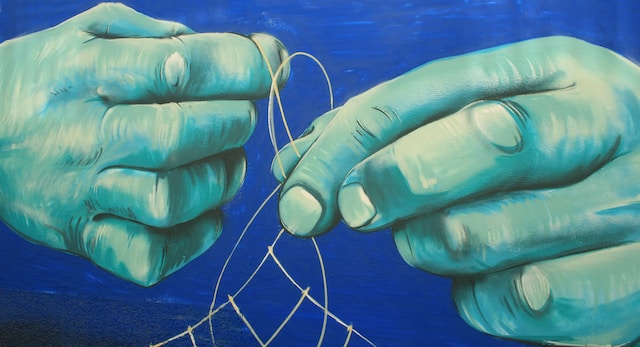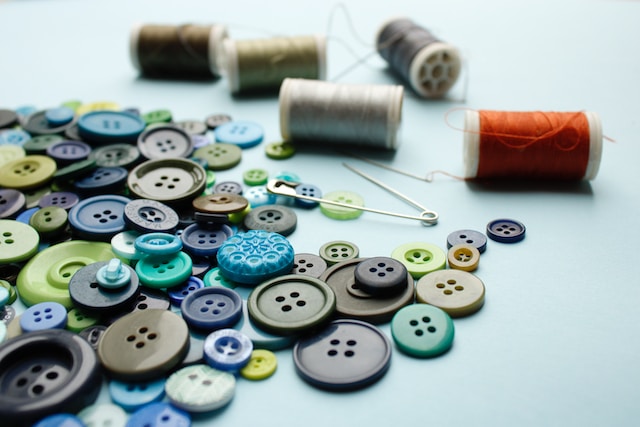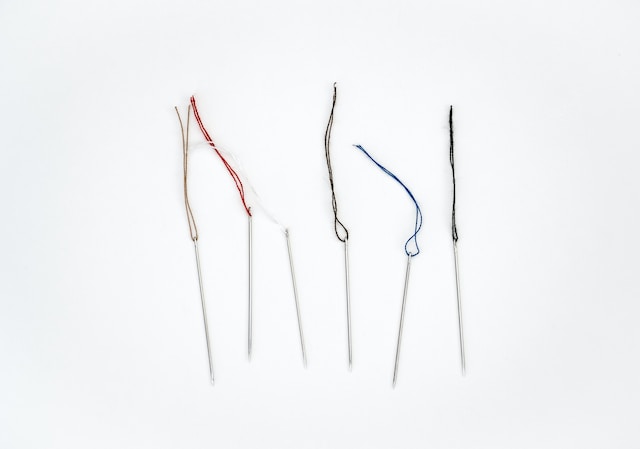Mastering the art of hand sewing is like unlocking a world of endless possibilities. Whether you’re repairing a beloved garment, adding intricate details to a homemade creation, or simply indulging in the therapeutic rhythm of stitching, knowing different hand-sewing stitches can elevate your skills to new heights. This blog post explores five popular 5 hand-sewing stitches and their uses. So grab your needle and thread – it’s time to unravel the secrets behind these versatile techniques!

What are Hand-Sewing Stitches?
Hand-sewing stitches are the backbone of any successful sewing project. They are created using a needle and thread to join fabric or other materials. Unlike machine stitches, which are quick and efficient, hand-sewing stitches offer more control and precision.
The 5 Most Popular Hand-Sewing Stitches
When it comes to hand sewing, knowing a variety of stitches can make all the difference in creating beautiful and durable pieces. Here are five of the most popular hand-sewing stitches and their uses:
1. Running Stitch

Running Stitch is one of the most basic and versatile hand-sewing stitches. It consists of a series of straight, evenly-spaced stitches that run parallel to each other. This stitch is commonly used for basting, gathering fabric, and creating simple decorative effects.
To create a running stitch, simply bring the needle up through the fabric and then back down in a continuous motion. The length between each stitch can be adjusted depending on your desired outcome. For example, shorter stitches create more secure seams while longer stitches are ideal for temporarily holding pieces together.
This stitch is perfect for beginners as it requires minimal skill or experience. It’s also great for quick repairs or when you need to sew something in a hurry. Running stitch can be used on various types of fabrics including cotton, linen, and even stretchy materials like knits.
If you want to add some extra flair to your running stitch, try using contrasting thread colors or varying the length between each stitch for an interesting visual effect.
Running stitch is an essential hand-sewing technique that every DIY enthusiast should have in their repertoire. Its simplicity makes it accessible to all skill levels while still offering endless possibilities for creative experimentation!
2. Backstitch

Backstitch is a versatile hand-sewing stitch that is commonly used for joining two pieces of fabric together. It is known for its strength and durability, making it ideal for seams that require extra reinforcement.
To create a backstitch, start by bringing the needle up through the fabric from the backside. Then, insert the needle back into the fabric slightly ahead of where it came out. Next, bring the needle up again in line with the previous stitch and pull it tight to secure the thread.
One great advantage of using backstitch is that it creates a neat and even row of stitches on both sides of the fabric. This makes it suitable not only for functional purposes but also for decorative stitching or embroidery projects.
Due to its stronghold, the backstitch can be used to repair tears or reinforce areas prone to stress, such as pocket corners or buttonholes. It’s also commonly used in garment construction when sewing darts or attaching collars and cuffs.
All in all, mastering this classic hand-sewing technique will greatly enhance your sewing skills and allow you to tackle a wide range of projects with confidence!
3. Slip Stitch

Slip stitch is a versatile hand-sewing stitch that has a variety of uses. It is often used to create invisible seams or to join fabric edges together seamlessly. This makes it ideal for hemming garments or attaching linings.
To execute a slip stitch, bring the needle up through the folded edge of one piece of fabric and then insert it into the opposite fold. Repeat this process, taking small, nearly invisible stitches along the seam line.
One of the great things about slip stitching is that it can be done by hand without any special tools or equipment. All you need is a needle and thread in a matching color to your fabric.
In addition to its practical applications, slip stitch can also be used decoratively. For example, it can be used to attach appliques or trims onto fabric without visible stitches.
Slip stitching is an essential technique for anyone who enjoys sewing by hand. Its versatility and ease make it an invaluable skill to have in your sewing repertoire!
4. Blanket Stitch

Blanket stitch is a versatile hand-sewing stitch that can add both functionality and decorative detail to your projects. It gets its name from its traditional use in creating edges or hems on blankets, but it can be used for so much more!
This stitch creates a neat and sturdy finish by looping the thread around the edge of the fabric. It is commonly used to prevent fraying on raw edges, making it perfect for appliqué work or securing patches onto garments. The looped construction of the blanket stitch also gives it a beautiful scalloped appearance, making it ideal for adding decorative borders to pillows, tea towels, or even clothing.
To create a blanket stitch, start by bringing the needle up through the fabric from back to front at your desired starting point. Then, take another small horizontal stitch towards the inside of your fabric and bring the needle back up through this loop. Repeat these steps along the edge of your fabric, keeping each subsequent loop evenly spaced apart.
Whether you are looking to reinforce seams or enhance your embroidery projects with intricate detail, the blanket stitch is a technique worth mastering. With just a few simple stitches, you can elevate your handmade creations with professional-looking finishes that will stand out and impress! So grab some thread and practice this versatile hand-sewing stitch today!
5. Buttonhole Stitch

Buttonhole stitch is a versatile and decorative hand-sewing stitch that is commonly used for securing buttonholes and adding a professional finish to garments. It creates a sturdy edge that prevents fraying, making it ideal for reinforcing openings in fabrics.
To create the buttonhole stitch, start by bringing the needle up through the fabric at one end of the buttonhole. Then, take a small horizontal stitch along the edge of the opening and bring the needle back down through both layers of fabric. Next, bring the needle up again slightly to create a loop on top of the previous stitch. Pass your needle through this loop from front to back, creating a knot-like structure.
Continue repeating these steps along both sides of the buttonhole until you reach the other end. The result is a neat row of stitches that securely hold together your buttonhole while adding an attractive finished look.
Aside from its functional purpose, buttonhole stitch can also be used decoratively in embroidery projects or as an edging for applique work. Its versatility allows for endless creative possibilities!
Whether you’re working on clothing repairs or enhancing your craft projects, mastering different hand-sewing stitches like buttonhole stitch opens up new avenues for creativity and ensures strong and durable finishes. So grab your needle and thread and start exploring all that this wonderful technique has to offer!
Conclusion

In this article, we have explored the world of hand-sewing stitches and their uses. Hand sewing is not only a practical skill but also an art form that allows us to create beautiful and functional pieces.
We discussed five popular hand-sewing stitches: the running stitch, backstitch, slip stitch, blanket stitch, and buttonhole stitch. Each of these stitches has its own unique characteristics and applications.
The running stitch is great for basting or joining fabrics temporarily. The backstitch provides strength and durability in seams or decorative embroidery. The slip stitch is perfect for invisible hems or closing openings on garments. The blanket stitch adds a decorative edge to the fabric or secures appliques. And finally, the buttonhole stitch creates sturdy buttonholes on clothing items.
By understanding these stitches and their uses, you can confidently tackle various sewing projects with ease. Whether you are repairing a garment, creating new clothes from scratch, or adding embellishments to your crafts; knowing how to use different hand-sewing stitches will greatly enhance your skills as a seamstress.
Remember that practice makes perfect when it comes to mastering hand-stitching techniques. So don’t be afraid to experiment with different types of fabric and threads until you find what works best for you.
So go ahead and grab your needle and thread! Start exploring the world of hand sewing stitches today and unlock endless possibilities in your creative journey! Happy stitching!
